Not sure which plants are best for your home? Check out our 12 steps for finding the perfect home plants!
I can’t think of anything more rewarding than being able to share your love of plants with others and seeing them get as excited about plants as you are. – Niecy Nash
Are you looking for the perfect home plants? Do you want to add some greenery to your home but don’t know where to start? Look no further! In this blog post, we’ll share 12 steps to finding the perfect home plants for your space.
You’ll learn about different types of plants, how to care for them, and what to consider when choosing plants for your home. By the end of this post, you’ll be an expert on finding the right plants for your space and lifestyle. So let’s get started!
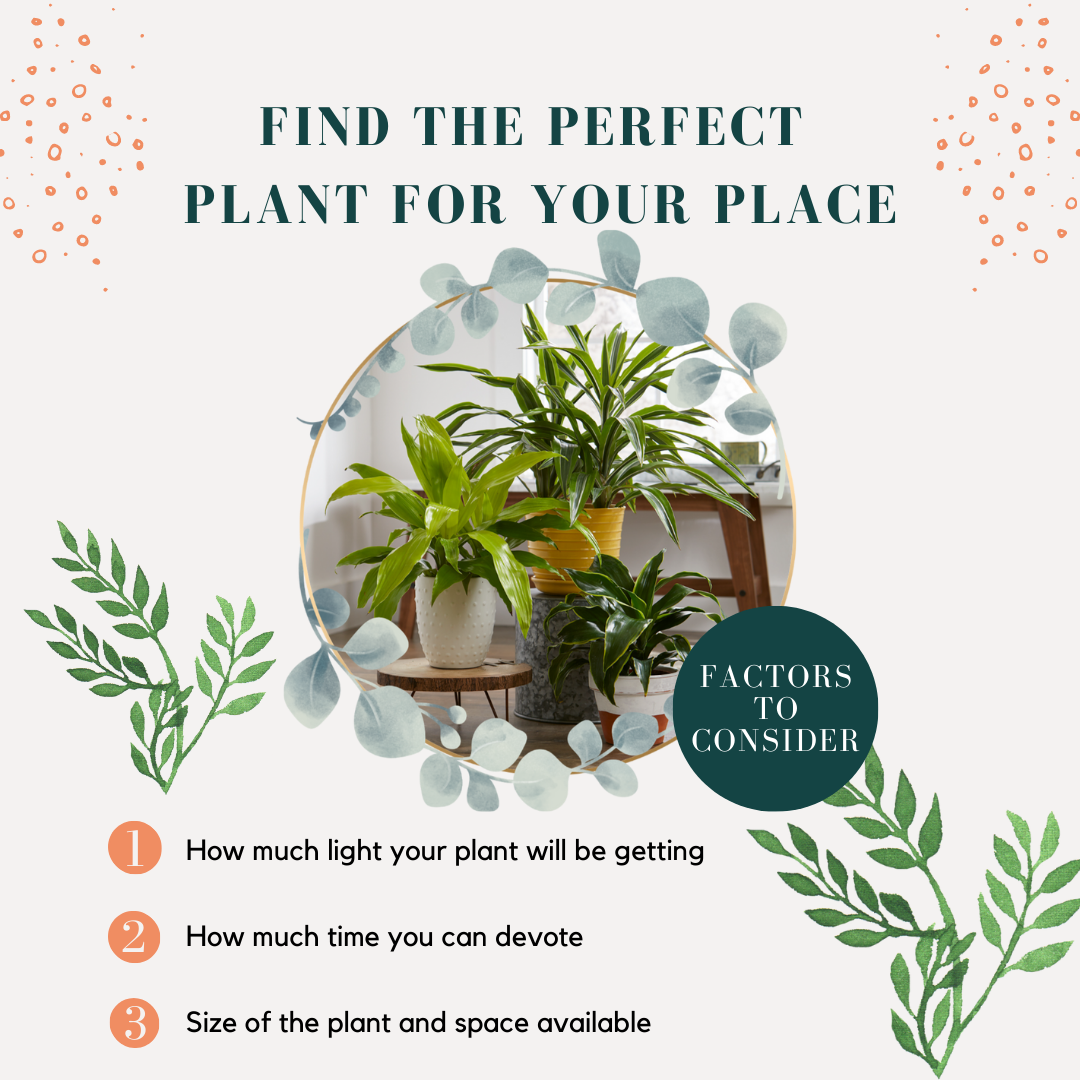
How To Choose The Right Plants For Your Home
When it comes to choosing plants for your home, there are a few things you need to take into account in order to make sure you select the best possible option for your space.
First, you need to consider the amount of light that the plant will need in order to thrive. If you do not have a lot of natural light in your home, then you will need to choose a plant that does not require a lot of sun in order to survive.
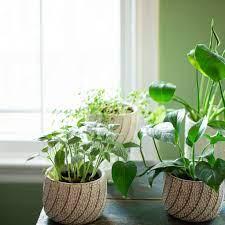
Another important factor to consider is the amount of care that the plant will need in order to stay healthy. If you do not have a lot of time to dedicate to plant care, then you will need to choose a plant that is relatively low-maintenance.
Finally, you need to think about the size of the plant and whether or not it will be able to fit in the space you have available.
Once you have considered all of these factors, you should have a better idea of what type of plant will be the best fit for your home. If you are still unsure, you can always consult with a professional at your local nursery or gardening store. They will be able to help you select the perfect plant for your space and give you tips on how to care for it.
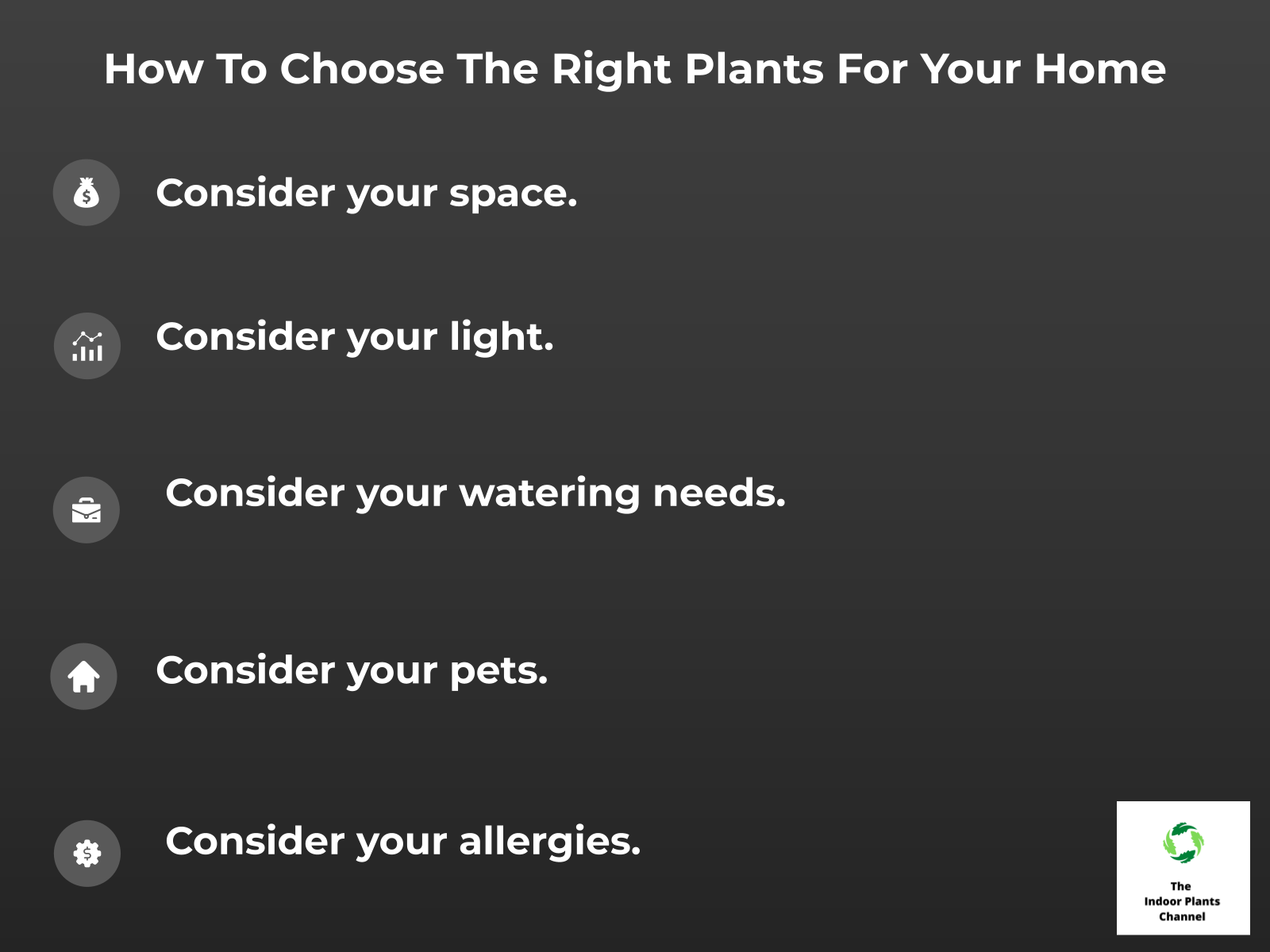
How To Care For Your Plants
Assuming you have already brought your plants home, here are a few tips on how to care for them:
1. Make sure you have the right potting mix for your plant. Different plants need different mixes, so ask at your local nursery or garden center.
2. Once you have the potting mix, pot your plant in a pot that has drainage holes. This will help prevent root rot, which can kill your plant.
3. Water your plant regularly, but don’t overwater it. Check the soil before watering to see if it is dry.
4. Place your plant in a location where it will get the right amount of light. Too much or too little light can stress your plant and make it more susceptible to pests and diseases.
5. Feed your plant regularly with a good quality fertilizer. This will help it stay healthy and promote growth.
6. Prune your plant regularly to remove dead or dying leaves and stems. This will help it look its best and encourage new growth.
7. Check your plant regularly for pests and diseases. If you see any, treat them immediately.
By following these simple tips, you can keep your plants healthy and happy for many years to come.
How To Make Your Plants Thrive
1. Get to know your plants.
2. Give them the right environment.
3. Give them the right amount of water.
4. Give them the right amount of light.
5. Give them the right amount of food.
6. Keep them clean.
7. Prune them.
8. Check for pests and diseases.
9. Be patient.
The first step to making your plants thrive is to get to know them. What kind of plants do you have? What are their needs? Do some research and find out everything you can about your plants.
The second step is to give your plants the right environment. Each plant is different and has different needs. Some plants need more light than others, some need more water, and some need more humidity. Make sure you know what your plant needs and give it the right environment.
The third step is to give your plants the right amount of water. Too much water can kill your plants, just as too little water can. Again, it depends on the plant. Some plants need to be watered every day, while others need to be watered once a week. Get to know your plants and water them accordingly.
The fourth step is to give your plants the right amount of light. Just as with water, too much or too little light can be harmful to your plants. Some plants need direct sunlight, while others need only indirect sunlight. Know your plants and give them the right amount of light.
The fifth step is to give your plants the right amount of food. Just as people need the right amount of food to stay healthy, so do plants. Overfeeding your plants can be just as harmful as underfeeding them. Know what kind of fertilizer your plants need and give them the right amount.
The sixth step is to keep your plants clean. Just as you would dust and vacuum your house, you need to dust and clean your plants. Dust can accumulate on the leaves of your plants and block their pores, preventing them from breathing. Use a soft brush or cloth to dust your plants.
The seventh step is to prune your plants. Pruning helps your plants stay healthy by removing dead or dying leaves and branches. It also helps encourage new growth. When pruning, be sure to use sharp, clean shears.
The eighth step is to check your plants for pests and diseases. Pests can harm your plants and spread diseases. Inspect your plants regularly and remove any pests you find. If you see any signs of disease, such as yellowing leaves or wilting, contact a professional.
The final step is to be patient. Plants take time to grow and thrive. Be patient and give your plants the time they need. With a little care and attention, your plants will thrive.
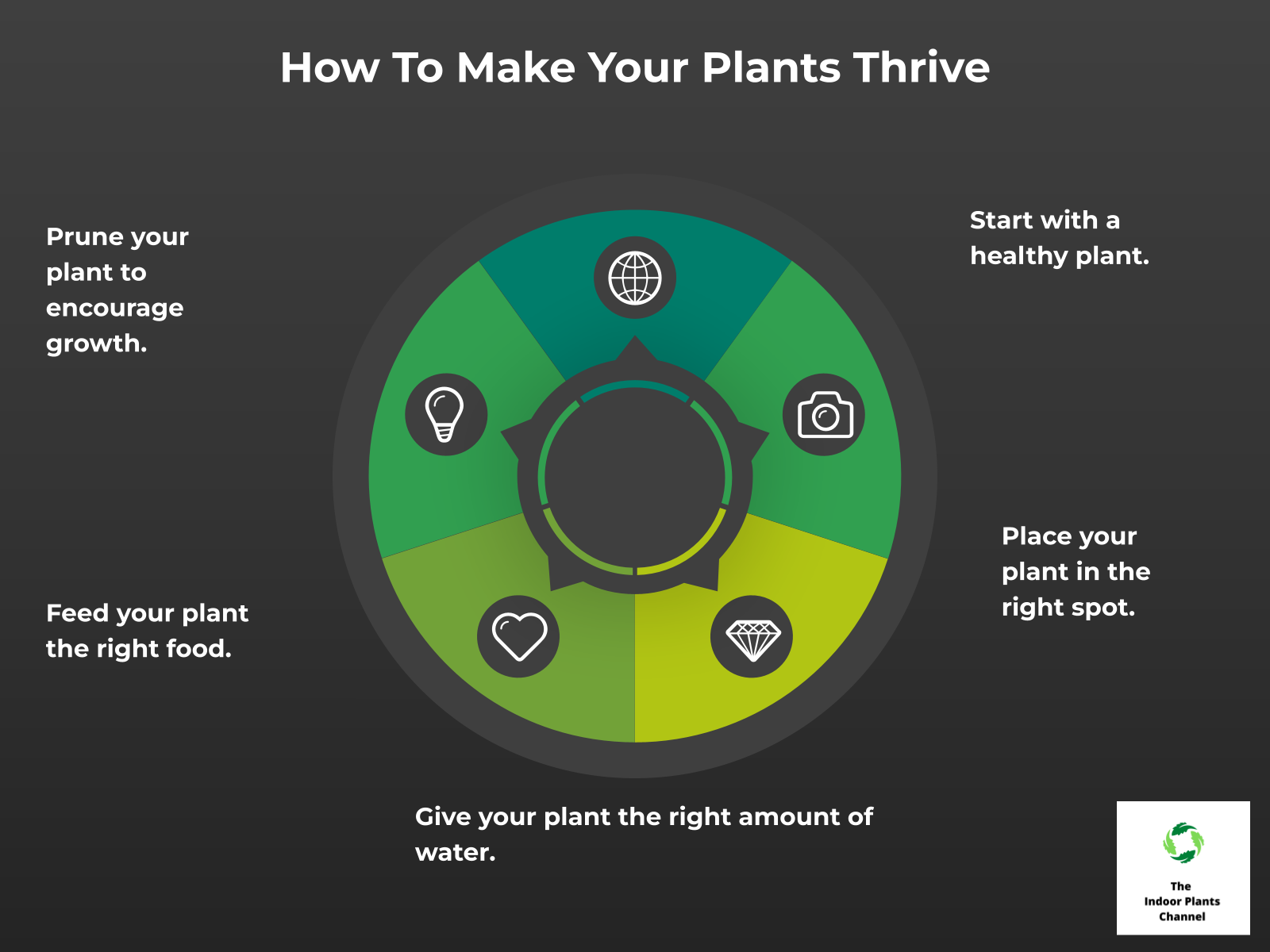
The Benefits Of Owning Plants
As you probably know, plants are living things that convert sunlight into energy. But did you know that there are many benefits to owning plants??
For starters, plants can help improve the air quality in your home. They do this by absorbing carbon dioxide and releasing oxygen. This is especially beneficial if you live in an urban area with a lot of pollution.
Plants can also help reduce stress and anxiety. Studies have shown that being around plants can help lower blood pressure and heart rate. Plants can also help you focus and improve your concentration.
Owning plants can also improve your physical health. Plants can help purify the air, which can help reduce the risk of respiratory problems. Plants can also help reduce noise levels and provide a natural humidifier.
So, as you can see, there are many benefits to owning plants. If you’re looking for a way to improve your home and your health, consider adding some plants to your life.
The Best Plants For Beginners
If you’re new to the world of plants, it can be tricky to know where to start. But don’t worry – we’ve got you covered. Here are 12 of the best plants for beginners, perfect for adding a bit of greenery to your home.
1. Snake Plant
One of the best things about snake plants is that they’re practically indestructible. They’re very tolerant of neglect and can go for long periods of time without water. They’re also happy in a wide range of lighting conditions, making them ideal for beginners.
2. Spider Plant
Spider plants are another great option for those new to plants. They’re very easy to care for and are very forgiving if you forget to water them occasionally. They’re also great at filtering the air, so they’re perfect for improving the quality of your indoor space.
3. Aloe Vera
Aloe vera is a great plant for beginners as it’s very easy to care for. It doesn’t need much water and can tolerate a wide range of lighting conditions. Plus, it has many benefits – it can be used to soothe burns, cuts and other skin irritations.
4. Pothos
Pothos are one of the most popular houseplants around, and it’s easy to see why. They’re very easy to care for, tolerate a wide range of conditions and are very attractive plants. They’re also great at purifying the air, so they’re perfect for improving the quality of your indoor space.
5. Rubber Plant
Rubber plants are a great choice for beginners as they’re very easy to care for. They don’t need much water and can tolerate a wide range of lighting conditions. They’re also attractive plants that can add a touch of style to your home.
6. Dracaena
Dracaenas are a great choice for beginners as they’re very easy to care for. They don’t need much water and can tolerate a wide range of lighting conditions. They’re also attractive plants that can add a touch of style to your home.
7. Fiddle Leaf Fig
Fiddle leaf figs are a popular choice for beginners as they’re very easy to care for. They don’t need much water and can tolerate a wide range of lighting conditions. They’re also attractive plants that can add a touch of style to your home.
8. Jade Plant
Jade plants are a great choice for beginners as they’re very easy to care for. They don’t need much water and can tolerate a wide range of lighting conditions. They’re also attractive plants that can add a touch of style to your home.
9. Peace Lily
Peace lilies are a great choice for beginners as they’re very easy to care for. They don’t need much water and can tolerate a wide range of lighting conditions. They’re also attractive plants that can add a touch of style to your home.
10. Philodendron
Philodendrons are a great choice for beginners as they’re very easy to care for. They don’t need much water and can tolerate a wide range of lighting conditions. They’re also attractive plants that can add a touch of style to your home.
11. Snake Plant
Snake plants are a great choice for beginners as they’re very easy to care for. They don’t need much water and can tolerate a wide range of lighting conditions. They’re also attractive plants that can add a touch of style to your home.
12. ZZ Plant
ZZ plants are a great choice for beginners as they’re very easy to care for. They don’t need much water and can tolerate a wide range of lighting conditions. They’re also attractive plants that can add a touch of style to your home.
The Easiest Plants To Care For
There are a few things to consider when picking plants for your home. But if you’re looking for something low-maintenance, these are the best options.
1. Snake Plants
Snake plants are one of the most popular houseplants for a reason: they’re practically indestructible. They’re tolerant of a wide range of conditions, including low light and irregular watering. Just make sure not to overwater them, as that can lead to root rot.
2. Succulents
Succulents are another great option for those who aren’t exactly green thumbs. They store water in their leaves, so they can go longer without being watered. They also don’t need a lot of light, making them perfect for rooms with little natural light. Just be careful not to water them too much, as that can cause them to rot.
3. Pothos
Pothos are a type of vine that’s known for being easy to care for. They’re tolerant of a wide range of conditions, including low light and irregular watering. They can also be easily propagated, so you can have more plants without having to buy more.
4. Philodendrons
Philodendrons are another type of vine that’s easy to care for. They’re tolerant of a wide range of conditions, including low light and irregular watering. They can also be easily propagated, so you can have more plants without having to buy more.
5. Spider Plants
Spider plants are one of the most popular houseplants for a reason: they’re practically indestructible. They’re tolerant of a wide range of conditions, including low light and irregular watering. They can also be easily propagated, so you can have more plants without having to buy more.
These are just a few of the many easy-to-care-for plants out there. With a little research, you can find the perfect plant for your home and lifestyle.
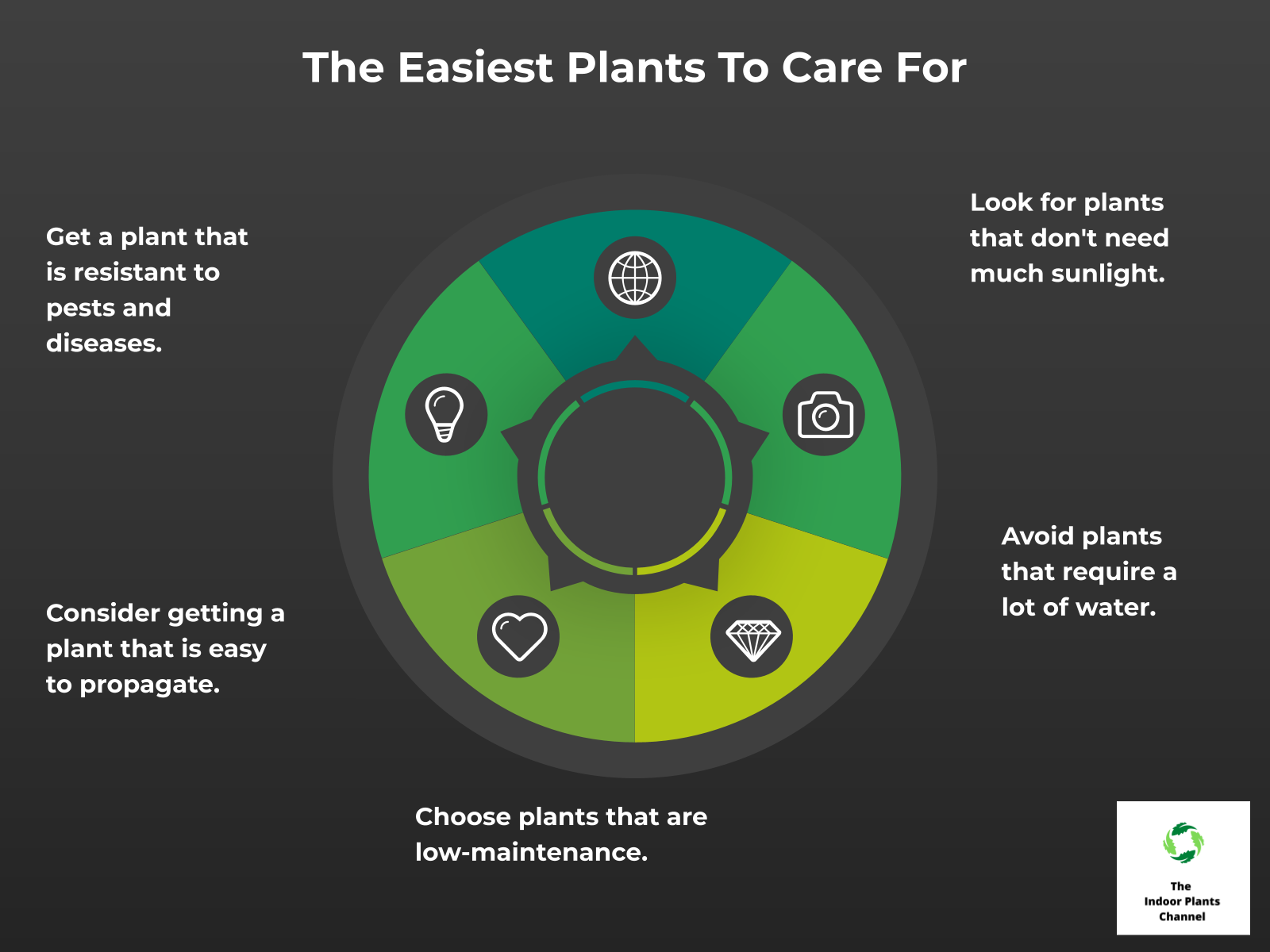
The Most Popular Houseplants
Houseplants are a great way to add some life to your home. They can help purify the air, provide you with fresh oxygen, and even improve your mood. But with so many different types of houseplants out there, it can be tricky to know which ones to choose.
Luckily, we’ve put together a list of the most popular houseplants to help you make a decision. From easy-to-care-for succulents to statement-making fiddle leaf figs, there’s sure to be a plant on this list that’s perfect for your home.
1. Succulents
Succulents are a great option for those who want a low-maintenance plant. These drought-resistant plants come in a wide range of shapes, sizes, and colors, so you can easily find one that fits your style. Plus, they don’t need much water or sunlight, making them perfect for busy homeowners or those with less-than-ideal conditions for plant-growing.
2. Snake Plants
Snake plants are another easy-to-care-for option that are perfect for busy homeowners or those new to plant-parenting. These tough plants can survive in a wide range of conditions, from low-light rooms to drafty windowsills. Snake plants also release oxygen at night, making them a great option for bedrooms.
3. Peace Lilies
Peace lilies are a beautiful and popular option for those looking for a flowering houseplant. These plants prefer shady conditions and moist soil, so they’re perfect for rooms that don’t get a lot of sunlight. Peace lilies can also help purify the air, making them a great choice for homes with pets or smokers.
4. Fiddle Leaf Figs
Fiddle leaf figs are a popular choice for those looking for a statement-making plant. These large plants can grow up to 10 feet tall, making them a dramatic addition to any room. Fiddle leaf figs prefer bright, indirect sunlight and regular watering, so they’re best suited for rooms with ample natural light.
5. Philodendrons
Philodendrons are a great choice for those looking for a climbing plant. These vines can grow up to 20 feet long, making them perfect for draping over shelves or cascading down from hanging baskets. Philodendrons prefer bright, indirect sunlight and moist soil, so they’re a good option for rooms with good air circulation.
6. Spider Plants
Spider plants are a popular choice for those looking for a hanging plant. These plants have long, cascading leaves that make them perfect for draping over shelves or hanging from baskets. Spider plants prefer bright, indirect sunlight and moist soil, so they’re a good option for rooms with good air circulation.
7. Dracaenas
Dracaenas are a popular choice for those looking for a tall, statement-making plant. These plants can grow up to 10 feet tall, making them a dramatic addition to any room. Dracaenas prefer bright, indirect sunlight and moist soil, so they’re a good option for rooms with good air circulation.
8. Pothos
Pothos are a popular choice for those looking for a climbing or trailing plant. These plants have long, cascading leaves that make them perfect for draping over shelves or cascading down from hanging baskets. Pothos prefer bright, indirect sunlight and moist soil, so they’re a good option for rooms with good air circulation.
9. Aloe Vera
Aloe vera is a popular choice for those looking for a low-maintenance succulent. These plants are easy to care for and don’t need much water or sunlight. Aloe vera plants are also known for their healing properties, making them a great choice for homes with kids or pets.
10. Bamboo Palm
Bamboo palms are a popular choice for those looking for a tall, statement-making plant. These plants can grow up to 10 feet tall, making them a dramatic addition to any room. Bamboo palms prefer bright, indirect sunlight and moist soil, so they’re a good option for rooms with good air circulation.
11. Rubber Plant
Rubber plants are a popular choice for those looking for a tall, statement-making plant. These plants can grow up to 10 feet tall, making them a dramatic addition to any room. Rubber plants prefer bright, indirect sunlight and moist soil, so they’re a good option for rooms with good air circulation.
12. Weeping Fig
Weeping figs are a popular choice for those looking for a tall, statement-making plant. These plants can grow up to 10 feet tall, making them a dramatic addition to any room. Weeping figs prefer bright, indirect sunlight and moist soil, so they’re a good option for rooms with good air circulation.
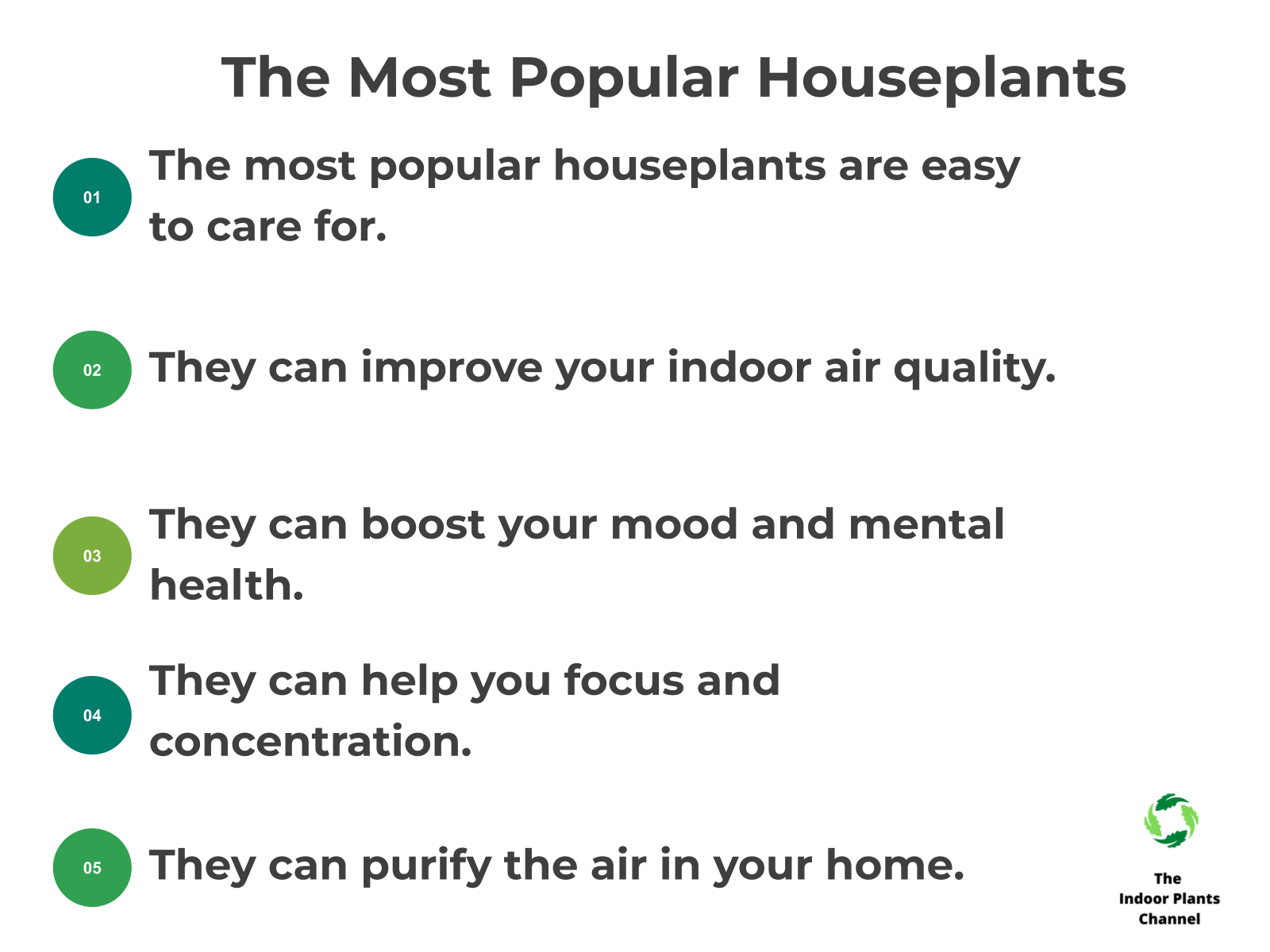
The Most Unique Houseplants
There are many different and unique houseplants that you can choose from to add to your home. Some of the most unique and interesting houseplants include:
1. The Venus flytrap – This plant is unique because it actually catches and eats insects!
2. The pitcher plant – This plant is unique because it has pitcher-shaped leaves that trap and digest insects.
3. The sundew plant – This plant is unique because it has leaves that are covered in sticky, sweet-smelling glands that attract and trap insects.
The Best Plants For Purifying The Air
According to the Environmental Protection Agency, indoor air can be up to five times more polluted than outdoor air. This is because most homes and buildings are designed to be energy efficient, which means that they are sealed up tight to prevent heat from escaping. This lack of ventilation can cause a build-up of pollutants, such as dust, mould, chemicals from cleaning products and paint, and VOCs (volatile organic compounds) from furniture and office equipment.
While there are many ways to improve indoor air quality, one of the most effective is to use air-purifying plants. Plants help to filter out harmful toxins and pollutants, and they also release oxygen and moisture into the air.
So, if you’re looking to improve your indoor air quality, here are 12 of the best air-purifying plants to get you started:
1. Aloe Vera
Aloe vera is a succulent plant that is often used in natural beauty products, but it also has air-purifying properties. Aloe vera releases oxygen at night, which helps to improve indoor air quality.
2. Bamboo Palm
The bamboo palm is a type of palm tree that can grow up to 10 feet tall. It is an effective air purifier, as it removes harmful toxins such as benzene, formaldehyde, and trichloroethylene from the air.
3. Boston Fern
The Boston fern is a type of fern that is known for its ability to thrive in humid environments. It is also an effective air purifier, as it helps to remove formaldehyde and other toxins from the air.
4. Chrysanthemum
The chrysanthemum is a flowering plant that comes in a variety of colors, including white, yellow, and pink. Chrysanthemums are effective air purifiers, as they help to remove toxins such as ammonia, benzene, formaldehyde, and xylene from the air.
5. English Ivy
English ivy is a type of ivy that is known for its ability to grow quickly and vigorously. English ivy is an effective air purifier, as it helps to remove toxins such as formaldehyde, benzene, and carbon monoxide from the air.
6. Gerbera Daisy
The Gerbera daisy is a type of daisy that is known for its large, brightly-colored flowers. Gerbera daisies are effective air purifiers, as they help to remove toxins such as benzene, formaldehyde, and trichloroethylene from the air.
7. Golden Pothos
Golden pothos is a type of plant that is known for its ability to thrive in a variety of environments. Golden pothos is an effective air purifier, as it helps to remove toxins such as carbon monoxide, formaldehyde, and xylene from the air.
8. Peace Lily
The peace lily is a type of plant that is known for its white flowers and ability to thrive in low-light conditions. Peace lilies are effective air purifiers, as they help to remove toxins such as ammonia, benzene, formaldehyde, and trichloroethylene from the air.
9. Snake Plant
The snake plant is a type of plant that is known for its ability to thrive in low-light conditions. Snake plants are effective air purifiers, as they help to remove toxins such as carbon monoxide, formaldehyde, and nitrogen dioxide from the air.
10. Spider Plant
The spider plant is a type of plant that is known for its ability to produce large numbers of baby plants, or “spiderettes.” Spider plants are effective air purifiers, as they help to remove toxins such as carbon monoxide, formaldehyde, and xylene from the air.
11. Weeping Fig
The weeping fig is a type of tree that is known for its ability to grow quickly and vigorously. Weeping figs are effective air purifiers, as they help to remove toxins such as formaldehyde, benzene, and carbon monoxide from the air.
12. ZZ Plant
The ZZ plant is a type of plant that is known for its ability to thrive in low-light conditions. ZZ plants are effective air purifiers, as they help to remove toxins such as carbon monoxide, formaldehyde, and xylene from the air.
Quick Tips
- Do your research – find out which plants are best suited to your home’s climate and conditions.
- Consider your home’s layout – make sure you have enough light and space for your chosen plants.
- Shop around – compare prices and find the best deals on plants and pots.
- Think about maintenance – choose plants that are easy to care for and won’t require too much work.
- Get creative – be imaginative with your plant choices and don’t be afraid to try something new.
- Ask for advice – if you’re unsure about anything, ask a professional or someone with more experience.
- Go for quality – choose plants that are healthy and will last longer.
- Make a plan – map out where you’re going to put your plants before you start buying them.
- Be patient – don’t expect your plants to grow overnight, they take time.
- Enjoy your plants – take pride in your new home plants and make the most of them.
- Be prepared to move them – some plants will eventually outgrow their pot or location, so be prepared to move them.
- Have fun – remember, this is supposed to be enjoyable so don’t take it too seriously!
Conclusion
If you’re looking for the perfect plants to spruce up your home, following these recommendations will help you find the best options to suit your needs. With a little research and some trial and error, you can have a thriving indoor plant collection in no time.
Michelle Wilde
Related posts
8 Comments
Leave a Reply Cancel reply
![]()
About Michelle Wilde
Michelle Wilde is a stay-at-home mom and avid plant lover. Armed with a post-graduate degree in Computer Science (no kidding!), she loves researching plants and landscapes. When she is not caring for her 4 kids, she spends time on her passion for plants. She blogs at www.indoorplantschannel.com, the trusted source for indoor plants.
Learn more
Subscribe
* You will receive the latest posts and updates about indoor plants!
Search
Recent Posts
Categories
- Beginner Guides (10)
- FAQ (206)
- General (2)
- How-To Guides (212)
- Indoor Plants (214)
- Pest Management (2)
- Plant Problem Solutions (4)
- Seasonal Growing (2)
- Specialized Environments (2)
- Specific Plant Care (3)
- Technical Growing (2)
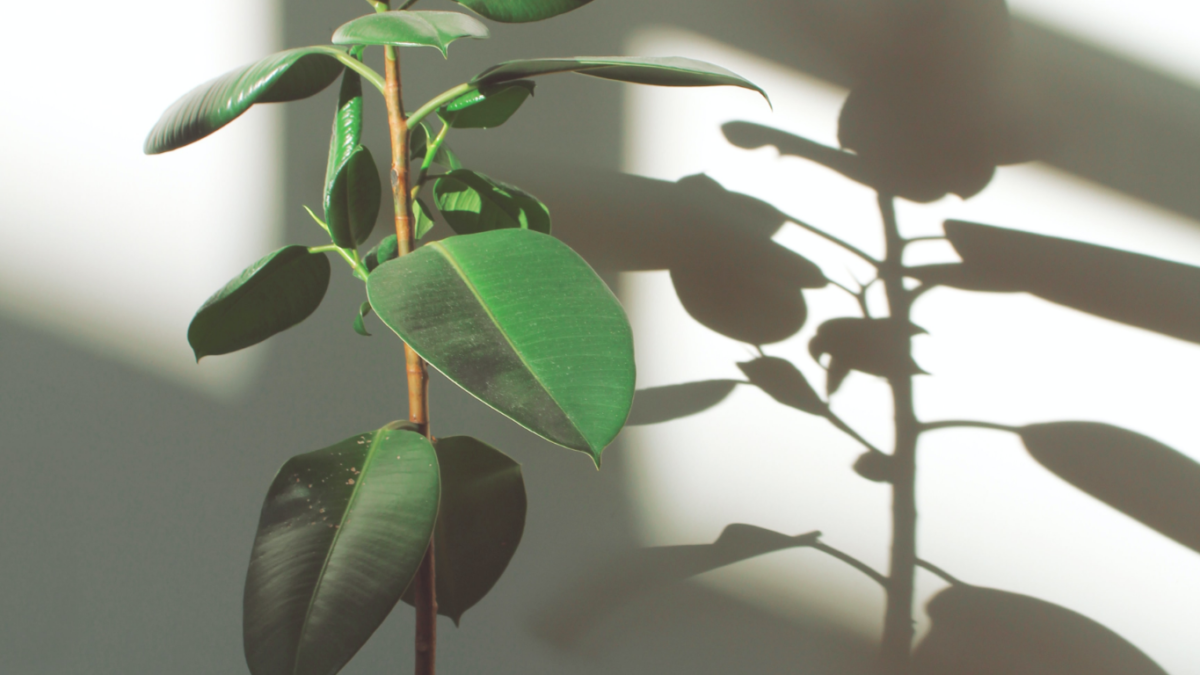
[…] are best suited for your space and lifestyle? Look no further than this comprehensive guide to the best plants for […]
[…] are lovely, leafy plants that make a great addition to any home. They come in many different varieties and can be propagated relatively […]
[…] sure to inspect your plants when you bring them home from the store or nursery, and quarantine any that have […]
[…] have been around for centuries, and their popularity has only grown in recent years. These plants are perfect for those who want to add a bit of personality to their home dcor, and they come in a wide variety of shapes and […]
[…] plants in your home can also lead to increased happiness. Studies have shown that being around plants can help to […]
[…] you’re looking for a low-maintenance plant to spruce up your home, office, or garden, consider investing in some fake […]
[…] if you’re looking for a low-maintenance plant to add to your home, an air plant is a great option! Just be sure to give it bright, indirect light and plenty of […]
[…] are all excellent choices that are relatively easy to care for. With a little research, you can find the perfect plant to suit your home and […]